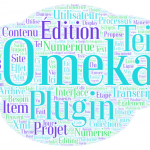Issue 11: Tools and Environments
Edited by Anna-Maria Sichani and Elena Spadini. January 2020. DOI: 10.18716/ride.a.11.
Reledmac. Typesetting technology-independent critical editions with LaTeX
Reledmac , Maïeul Rouquette (ed.), 1987-2019. https://ctan.org/pkg/reledmac (Last Accessed: 21.07.2019). Reviewed by Andrew N. J. Dunning (Bodleian Library, University of Oxford), andrew.dunning@bodleian.ox.ac.uk. ||
Abstract
Reledmac, an open-source package for the LaTeX typesetting system, offers a reliable method to arrange text on a page with multiple levels of scholarly apparatus and commentary. Its straightforward interface and wide availability has allowed its use in several projects aiming to visualize an edition encoded in TEI XML in a printed format.
Introduction
1 It is questionable whether anyone is happy with the traditional format of the critical printed edition. ...
Review of the Tübinger System von Textverarbeitungs-Programmen (TUSTEP)
Tustep - Tübinger System von Textverarbeitungs-Programmen , ITUG e. V. (ed.), 2018. https://www.tustep.uni-tuebingen.de/ (Last Accessed: 01.10.2019). Reviewed by Christian Griesinger (University of Wuppertal), griesinger@uni-wuppertal.de. ||
Abstract
This review deals with the Tübinger System von Textverarbeitungs-Programmen called TUSTEP. It describes some of the principal functions of TUSTEP, outlines sample use cases and shows benefits and downsides. While TUSTEP is one of the oldest and long-lasting applications in the area of text processing, its flexibility and functional scope make it worth to consider for present and future scientific projects dealing with text edition, m...
Omeka Classic. Un environnement de recherche pour les éditions scientifiques numériques
Omeka Classic , Elina Leblanc (ed.), 2019. https://omeka.org/classic (Last Accessed: 18.12.2019). Reviewed by Elina Leblanc (Université Grenoble Alpes), elina.leblanc@univ-grenoble-alpes.fr. ||
Abstract:
This review focuses on Omeka , an open-source Content Management System (CMS), which has been specifically designed for the management and the display of digitized historical content. Originally, this CMS was not intended for the creation and display of scholarly digital editions. However, the active community of Omeka ’s users has developed several plugins that can manage and display digital scholarly editions following the XML-TEI standard. This review will then present several of...
Ediarum. A toolbox for editors and developers
ediarum , Stefan Dumont, Martin Fechner, Sascha Grabsch (ed.), 2018. http://www.bbaw.de/telota/software/ediarum (Last Accessed: 15.10.2019). Reviewed by Andreas Mertgens (University of Cologne), a.mertgens@uni-koeln.de. ||
Abstract
ediarum.DB , ediarum.BASE.edit and ediarum.REGISTER.edit are the three currently released modules of the ediarum editing environment developed by the TELOTA initiative at the BBAW in Berlin. The set of two frameworks for the Oxygen XML Editor and one eXist-db application aims to support digital scholarly editors in generating and annotating TEI-XML Data. The frameworks offer a graphical interface within Oxygen XML Editor to add mark-up and metadata for...
Juxta Web Service, LERA, and Variance Viewer. Web based collation tools for TEI
Juxta Web Service , NINES, Performant Software, Gregor Middell, Ronald Dekker (ed.), 2009. http://juxtacommons.org/ (Last Accessed: 20.12.2019). LERA , Marcus Pöckelmann (ed.), 2015. http://lera.uzi.uni-halle.de/ (Last Accessed: 20.12.2019). Variance Viewer , Nico Balbach (ed.), 2018. http://variance-viewer.informatik.uni-wuerzburg.de/Variance-Viewer/ (Last Accessed: 20.12.2019). Reviewed by Torsten Roeder (Leopoldina), torsten.roeder@leopoldina.org. || Abstract: The review presents and compares three open source and web-based text collation tools, namely Juxta Web Service, LERA, and Variance Viewer, and investigates their suitability especially for philological work with TEI. While ...





